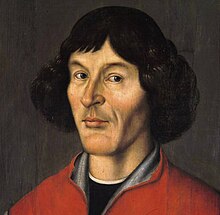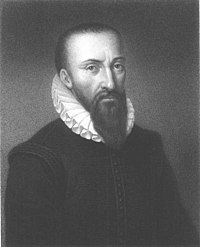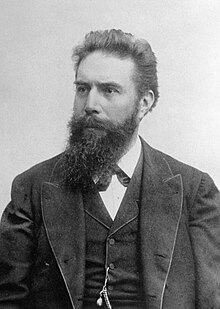
Nicolaus Copernicus
Biography: Nicolaus Copernicus was born on 19 February 1473 in the city of Toruń (Thorn), in the province of Royal Prussia, in the Crown of the Kingdom of Poland. His father was a merchant from Kraków and his mother was the daughter of a wealthy Toruń merchant. Nicolaus was the youngest of four children. His brother Andreas (Andrew) became an Augustinian canon at Frombork (Frauenburg). His sister Barbara, named after her mother, became a Benedictine nun and, in her final years, prioress of a convent in Chełmno (Kulm); she died after 1517. His sister Katharina married the businessman and Toruń city councilor Barthel Gertner and left five children, whom Copernicus looked after to the end of his life. Copernicus never married or had children.
Legacies, Discoveries & Contributions: The publication of this model in his book De revolutionibus orbium coelestium (On the Revolutions of the Celestial Spheres) just before his death in 1543 is considered a major event in the history of science, triggering the Copernican Revolution and making an important contribution to the Scientific Revolution.

Isaac Newton
Biography: Isaac Newton was born according to the Julian calendar (in use in England at the time) on Christmas Day, 25 December 1642 (NS 4 January 1643), at Woolsthorpe Manor in Woolsthorpe-by-Colsterworth, a hamlet in the county of Lincolnshire. He was born three months after the death of his father, a prosperous farmer also named Isaac Newton. Born prematurely, he was a small child; his mother Hannah Ayscough reportedly said that he could have fit inside a quart mug. When Newton was three, his mother remarried and went to live with her new husband, the Reverend Barnabas Smith, leaving her son in the care of his maternal grandmother, Margery Ayscough. The young Isaac disliked his stepfather and maintained some enmity towards his mother for marrying him, as revealed by this entry in a list of sins committed up to the age of 19: "Threatening my father and mother Smith to burn them and the house over them”. Newton's mother had three children from her second marriage. Although it was claimed that he was once engaged
Newton died in his sleep in London on 20 March 1727 (OS 20 March 1726; NS 31 March 1727) and was buried in Westminster Abbey. Voltaire may have been present at his funeral. A bachelor, he had divested much of his estate to relatives during his last years, and died intestate. After his death, Newton's hair was examined and found to contain mercury, probably resulting from his alchemical pursuits. Mercury poisoning could explain Newton's eccentricity in late life.
Legacies, Discoveries & Contributions: His book Philosophiæ Naturalis Principia Mathematica ("Mathematical Principles of Natural Philosophy"), first published in 1687, laid the foundations for classical mechanics. Newton made seminal contributions to optics, and he shares credit with Gottfried Leibniz for the development of calculus.

Ambroise Paré
Biography: Ambroise Paré (c. 1510 – 20 December 1590) was a French barber surgeon who served in that role for kings Henry II, Francis II, Charles IX and Henry III. He is considered one of the fathers of surgery and modern forensic pathology and a pioneer in surgical techniques and battlefield medicine, especially in the treatment of wounds. He was also an anatomist and invented several surgical instruments. He was also part of the Parisian Barber Surgeon guild.
In his personal notes about the care he delivered to Captain Rat, in the Piémont campaign (1537–1538), Paré wrote: " Je le pansai, Dieu le guérit " (I bandaged him and God healed him). This epitomises a philosophy that he used throughout his career. (Jean-Pierre Poirier, Ambroise Paré, Paris, 2006, p. 42.) At this time, little could be done for battlefield wounds and injured soldiers were often put out of their misery by comrades if the wound was too severe to be treated. During the 1536 Battle of Milan, Paré encountered two men who had been horribly burned by gunpowder. A soldier came up and asked if anything could be done to help them, to which he shook his head. The soldier then calmly took out his dagger and proceeded to cut their throats. A horrified Paré shouted that he was "a villain", to which he was told "Were I in such a situation, I would only pray to God for someone to do the same for me."
Legacies, Discoveries & Contributions: He is considered one of the fathers of surgery and modern forensic pathology and a pioneer in surgical techniques and battlefield medicine, especially in the treatment of wounds.

Wilhelm Conrad Röntgen
Biography: In 1865, he tried to attend the University of Utrecht without having the necessary credentials required for a regular student. Upon hearing that he could enter the Federal Polytechnic Institute in Zurich (today known as the ETH Zurich), he passed its examinations, and began studies there as a student of mechanical engineering. In 1869, he graduated with a Ph.D. from the University of Zurich; once there, he became a favorite student of Professor August Kundt, whom he followed to the University of Strassburg (then recently annexed by Germany) in 1873.
Legacies, Discoveries & Contributions: In honour of his accomplishments, in 2004 the International Union of Pure and Applied Chemistry (IUPAC) named element 111, roentgenium, a radioactive element with multiple unstable isotopes, after him.

Albert Einstein
Biography: Albert Einstein was born in Ulm, in the Kingdom of Württemberg in the German Empire on 14 March 1879. His parents were Hermann Einstein, a salesman and engineer, and Pauline Koch. In 1880, the family moved to Munich, where his father and his uncle founded Elektrotechnische Fabrik J. Einstein & Cie, a company that manufactured electrical equipment based on direct current.
On 17 April 1955, Albert Einstein experienced internal bleeding caused by the rupture of an abdominal aortic aneurysm, which had previously been reinforced surgically by Rudolph Nissen in 1948. He took the draft of a speech he was preparing for a television appearance commemorating the State of Israel's seventh anniversary with him to the hospital, but he did not live long enough to complete it.
Legacies, Discoveries & Contributions: Einstein's work is also known for its influence on the philosophy of science. Einstein is best known in popular culture for his mass–energy equivalence formula E = mc2 (which has been dubbed "the world's most famous equation"). He received the 1921 Nobel Prize in Physics for his "services to theoretical physics", in particular his discovery of the law of the photoelectric effect, a pivotal step in the evolution of quantum theory.
No comments:
Post a Comment